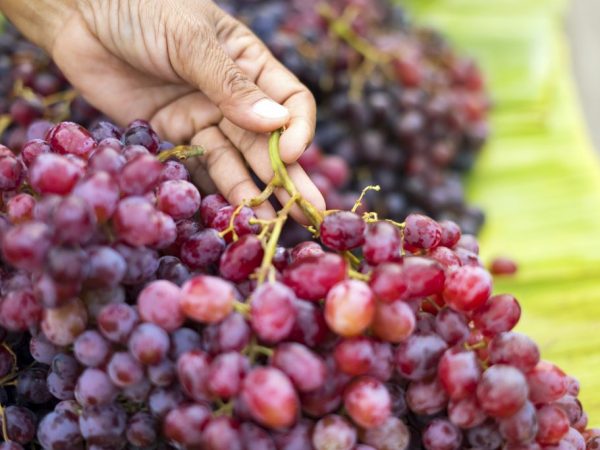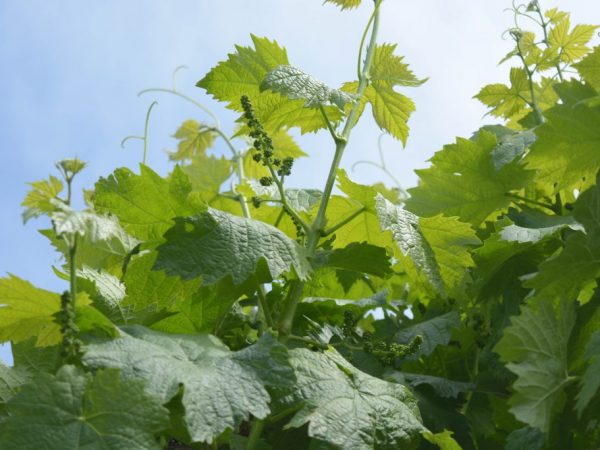Description of grapes raisins Aksaysky
Aksay kishmish grapes are considered the most popular type of this culture. The main advantages are high yield, resistance to gray rot, high transportability and good fruit taste. The culture is suitable for universal use.

Description of grapes raisins Aksaysky
Main characteristics
Aksay vineyard kishmish was obtained by crossing two varieties (Victoria × kishmish Novocherkasskiy). She has absorbed all the positive qualities from her predecessors. The grapes of this variety are included in the State Register of the Russian Federation.
Ripens early, literally in 110 days. Harvesting is carried out in early August. The height of the bushes is about 5-7 m, so they need to be shaped by the gardener. The flowering is female, there is a possibility of self-pollination.
When considering the description of the fruit, the following features should be highlighted:
- bunch weight 600-700 g;
- looseness and density are average;
- the berry is pink, oval in shape and weighing up to 4 g.
Taste and use
The description of Aksaysky raisins indicates that its taste is rich and pleasant. Due to the fact that the composition contains about 15% sugar, the fruits are sweet, but not sugary. The aroma is pleasant, with notes of nutmeg.
The bunches are versatile in use: they are consumed fresh, for making compotes or delicious dessert wine.
Growing possibility
Reproduction of this grape variety is done by cuttings, which allows you to achieve the following results:
- the growth of bushes increases;
- the root system is strengthened.
Planting is carried out in the fall. The culture is planted in shaded areas, since the bushes are damaged by abundant sunlight. The acidity of the soil should not exceed 3-5%. To do this, dig a hole 50x40 cm. 3-4 kg of humus are poured into the depths, and then left for 2-3 weeks.
It is important that the nutrients are absorbed into the ground. After that, a 2-year-old seedling is lowered into the hole so that the root collar is located above the surface of the earth. On the seedlings, 35-40 eyes should be formed. After that, the roots are sprinkled with earth and watering is carried out with 10 liters of water. A distance of 2-2.5 m is kept between seedlings.
Care features

Remove damaged areas of the plant in time
Aksai raisins have no essential care requirements.
- The irrigation system is normalized. It is carried out at intervals of 3-4 weeks. Water the plant only in the morning or in the evening so that the sun's rays do not evaporate moisture. The water should be at room temperature so that the roots are not stressed. Also p
- Loosening of the soil should be carried out regularly, which will allow the roots to receive the right amount of air and nutrients.
- This variety does not really need feeding, but if you want to increase the yield indicators, before the fruit ovary, the culture is fed with a mixture of ammonium nitrate (40 g) and superphosphate (50 g). This dosage of drugs is diluted in 10 liters of water. At least 25 liters of solution are poured under each seedling.
- In the spring, rejuvenating and regenerating pruning of branches is carried out. Dry, damaged areas that cannot set fruit should be removed. If you carry out such pruning regularly every year, then soon the entire area of the plant will be restored, and you will only need to cut off the regrown infertile shoots.
Pests and diseases
This variety is resistant to most diseases. The immune system is able to withstand diseases such as gray mold, mildew and powdery mildew. Of the main diseases to which this variety is exposed, powdery mildew is isolated. In an effective fight against it, the plant is treated with a solution of Bordeaux liquid (10 g per 10 l of water).
From pests, midges and aphids are isolated.
- Manganese solution is effective against midges (5 g per 10 l of water).
- To get rid of aphids will help the drug Zircon (30 g per 10 liters of water).
The culture should be sprayed at intervals of 10-15 days, until it is completely cured. As a preventive measure, monthly spraying with copper sulfate (20 g per 10 l of water) is carried out.
Conclusion
This variety has a number of advantages, but they will all be preserved only if the gardener carries out a high-quality planting and properly care for the plant. At the slightest deviation from the recommendations, there is a possibility of not only a decrease in yield, but also the death of a whole bush.


